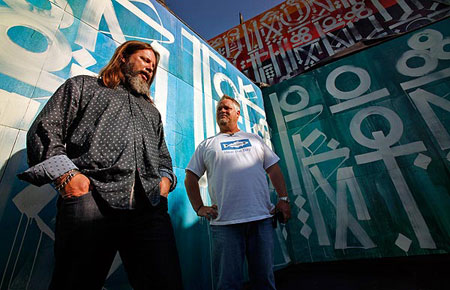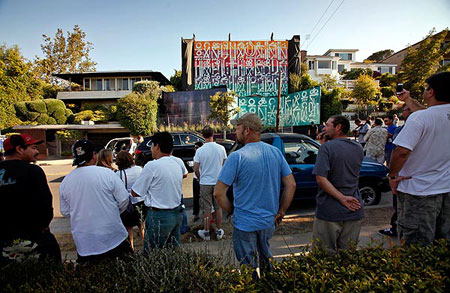Huge artwork suddenly appears in Santa Monica neighborhood
For much of the summer, the towering creation stood hidden behind a draping of blue and black tarps, looking like nothing more than a big home construction project.
On Thursday, workers stripped away the shrouds to reveal a startling, four-story-high art installation. Surrounded by homes in a quiet pocket of Santa Monica, the display consists of a series of 150 square panels — spray-painted yellow-orange, magenta, purple, sky blue and sea foam green. Each panel also bears a series of unidentifiable, white-painted characters that seem like a message scrawled by extraterrestrials. It quickly made waves among residents, with reactions running the gamut from «It’s amazing» to «It’s an eyesore.»
But the brash display could prove short-lived. Neither the developer nor the artists sought permits for the installation, and by late afternoon the city said it planned to issue an order for immediate removal. «Aside from all thoughts on the intent, message and look of the panels, my approach ... is that it is a health and safety concern and a hazard subject to immediate removal,» said building official Ron Takiguchi.
Many neighbors expressed support after learning that the installation was planned as a traveling exhibition to raise money for Santa Monica-based Heal the Bay and the Sea Shepherd Conservation Society, an international nonprofit, marine wildlife conservation group.
With the help of a landscaper, Adam Corlin, a Santa Monica developer who volunteers for Heal the Bay, enlisted two L.A. street-art pioneers — Risk and Retna — to realize his vision.
Risk (real name: Kelly Graval) helped bring Wild Style graffiti, with hard-to-decipher, interlocking letters, from the New York subways to the L.A. freeways. Retna (real name: Marquis Lewis) is known for creating an original script that fuses influences from Egyptian hieroglyphics, Old English, Arabic, Hebrew and Asian calligraphy. «The main thing about this mural is to bring people awareness of the whole issue,» the bearded artist said.
Corlin explained that the colors were meant to signify the sun (yellows), layers of pollution (purples) and the Earth (blues and greens). Corlin translated the script row by row: Oceans @ Risk, Heal the Bay, Sea Shepherd, Mad Society, Restore and Protect the World’s Oceans.
When Corlin and his business partner bought the property, it featured an abandoned, partially completed residence where homeless people occasionally squatted.
«Our street needs livening up,» said Jane Garnett, a resident pushing her daughters Zella, 4 1/2, and Mae, 1, in a double stroller. «It’s like a splash of energy.» Garnett said she wouldn’t mind if the installation became a permanent fixture in the eclectic neighborhood, where traditional bungalows mingle with massive contemporary houses. To her, the artwork called to mind «The Big Orange Splot,» a 1977 children’s book by Daniel Manus Pinkwater. The main character, Mr. Plumbean, lives on a «neat street» where all the houses look the same. A sea gull flies over his house and drops a can of bright orange paint on his roof. Rather than repaint his house to look like all the others, Mr. Plumbean paints it to look like his dreams. Before long, his neighbors are painting their abodes to match their dreams.
Source: Los Angeles Times
Calligraphy is a remedy and mental gymnastics.





